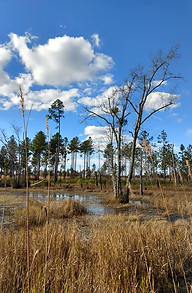Current research
I'm studying the population dynamics of a rare amphibian species endemic to the southeastern U.S., the Striped Newt (Notophthalmus perstriatus). I'm working to fill gaps in knowledge about the species' (particularly complex and enigmatic) life history and have developed a population model that will allow researchers, land managers, and conservation planners to better assess the status of extant and repatriated populations, make predictions about their future trajectories, and weigh the relative impact of alternative management interventions. This research has also involved experimental assessment of captive rearing and repatriation approaches to figure out what actually happens to Striped Newts post-release, inform best practices and cost-benefit analyses. In addition, I'm digging into the socio-ecological histories of Georgia public lands that are currently being managed for the conservation of Striped Newts, their habitat, and other rare animal and plant species that share the ecosystem. Decisions about how to manage land-- and who gets to make those decisions-- are always complex and involve trade-offs between different priorities. I'm hoping to better understand how these lands have been used by human communities over time, and how that history impacts the relationship of area residents and land managers to those places today.







Publications
*Cornelius, J. M., T. P. Hahn, A. R. Robart, B. J. Vernasco, D. L. Zahor, K. J. Glynn, C. J. Navis, and H. E. Watts. 2021. Seasonal patterns of fat deposits in relation to migratory strategy in facultative migrants. Frontiers in Ecology and Evolution 9:691808.
*Lundblad, C.G., C.J. Conway, K. Cruz-McDonnell, D. Doublet, M. Desmond, C. Navis, and K. Ongman. 2021. Long-term population fluctuations of a burrowing owl population on Kirtland Air Force Base, New Mexico. Journal of Raptor Research 55: 241–254.
Navis, C., C. Lundblad and C. Conway. 2018. Burrowing Owls (Athene cunicularia hypugaea) on Kirtland Air Force Base: Monitoring, Management, and Population Status - 2018 Annual Report. Idaho Cooperative Fish and Wildlife Research Unit.
Navis, C., C. Lundblad and C. Conway. 2017. Burrowing Owls (Athene cunicularia hypugaea) on Kirtland Air Force Base: Monitoring, Management, and Population Status - 2017 Annual Report. Idaho Cooperative Fish and Wildlife Research Unit.
Navis, C. J. 2017. The impact of urban centers on American goldfinches (Spinus tristis) overwintering at high latitudes. EMU Master's Theses and Doctoral Dissertations 908.
(*peer-reviewed)
Research Presentations
Navis, C. J., D. R. Bradke and J. C. Maerz. 2024. Navigating the unknown: Using population viability analysis to inform Striped Newt management. Southeast Partners in Amphibian and Reptile Conservation Annual Meeting (oral presentation)
Navis, C. J., D. R. Bradke and J. C. Maerz. 2024. Striped Newts: What are they even doing?? Using population viability analysis to gain insights and weigh alternative management approaches. Striped Newt Working Group meeting (oral presentation)
Carter, C. M. and C. J. Navis.* 2023. Undergraduate student experiences with a non-traditional grading approach. University System of Georgia (USG) Teaching & Learning Conference (oral presentation)
(*equal co-authors and co-presenters)
Navis, C. J. and J. C. Maerz. 2023. Arrested Development: Time in captivity disrupts the typical life history of captive-reared Striped Newts released into a natural wetland environment. Southeast Partners in Amphibian and Reptile Conservation Annual Meeting (poster)
Navis, C. J. and J. C. Maerz. 2022. Optimizing Striped Newt captive rearing based on post-release survival and developmental outcomes. Georgia Department of Natural Resources research meeting (oral presentation)
Navis, C. J. and J. C. Maerz. 2022. Optimizing Striped Newt captive rearing based on post-release survival and developmental outcomes. Joint Meeting of Ichthyologists and Herpetologists (oral presentation)
Navis, C. J. and J. C. Maerz. 2021. Striped Newt demography and conservation research at the University of Georgia. Striped Newt Working Group meeting (oral presentation)
Navis C. J., C. Hazelrig, and J. C. Maerz. 2021. Striped Newt demography and management in Georgia. Georgia Department of Natural Resources research meeting (oral presentation)
Hazelrig C., K. Garrett, C. J. Navis, J. C. Maerz, N. Nemeth, and M. J. Yabsley. 2021. Surveillance and assessment of skin keratin abundance associated with Batrachochytrium dendrobatidis prevalence in red-spotted newts and mole salamanders. Wildlife Disease Association/European Wildlife Disease Association joint conference (poster)
Navis, C. J. 2021. Conservation of a rare amphibian on south Georgia public lands. Symposium for Integrative Conservation, University of Georgia (oral presentation)
Maerz J. C., E. Noriega, M. Lambert, C. Navis, J. Katterjohn, and V. Kinney Terrell. 2020. Temperature dependent sex determination of captive-reared Gopher Frogs. Southeast Partners in Amphibian and Reptile Conservation annual meeting (poster)
Navis, C. J., P. Bednekoff, and J. M. Cornelius. 2017. Winter corticosterone responses in American Goldfinches (Spinus tristis) in urban and rural environments. Society for Integrative and Comparative Biology Annual Meeting (oral presentation)
Campbell, K. E., C. Navis, and J. M. Cornelius. 2017. Investigating the influence of stress hormones on the differential migratory behavior of the American Goldfinch (Spinus tristis). Society for Integrative and Comparative Biology Annual Meeting (poster)
Navis, C. J., J. M. Cornelius, and P. Bednekoff. 2016. The role of cities in facilitating American Goldfinch (Spinus tristis) overwintering at high latitudes. Michigan Academy of Science, Arts and Letters Conference (oral presentation)
Navis, C. J., J. M. Cornelius, and P. Bednekoff. 2016. The role of cities in facilitating American Goldfinch (Spinus tristis) overwintering at high latitudes. Midwest Fish and Wildlife Conference (oral presentation)
Navis, C. J. 2015. Bird undeterred: Understanding how American Goldfinches (Spinus tristis) survive harsh northern winters. Eastern Michigan University Graduate Research Conference (oral presentation)



